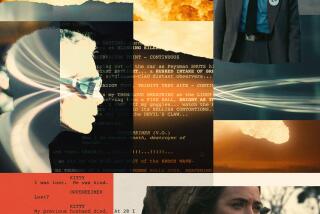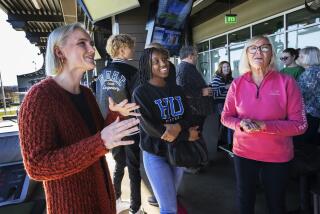I Touch the Future,’ Part V : The McAuliffe Family Is Finding Signs of Hope Amid the Grief
- Share via
Six months after Challenger lifted off, Christa McAuliffe’s remains lay in an unmarked grave overlooking a winding river and the evergreen hills near her New Hampshire home. Two freshly planted maples framed the burial spot, a pot of red geraniums blooming between them. A few tiny American flags snapped in the summer wind, and hidden in the grass beneath the flags was a lapel pin depicting the launch of a space shuttle. It said, “I want to GO.”
Those were the only visible signs that Christa had returned to Concord from shuttle mission 51-L. Her husband, Steve, wanted it that way. He had watched Challenger burst from its giant steam cloud and rocket skyward at twice the speed of sound. He had seen it explode 73 seconds into flight, sending Christa and her companions to their deaths. Then he had fled into seclusion, sad, lonely and angry, trying to cope with the tragedy and to protect his private memories of a wife whose life and death had become so public.
Steve had leaned on Christa. She had nurtured and counseled and shepherded him for so long that while her absence in the months before the Challenger mission helped him prepare for life as a single parent, nothing had prepared him for living without her.
Steve stayed with 8-year-old Scott and 5-year-old Caroline in Florida in the days after the explosion, trying to help them understand what had happened before they returned to a home filled with reminders of their mother. Scott soon accepted Christa’s death, but Caroline needed time. She remembered Christa coming and going so often in recent months that she believed Christa would return again. Caroline was confused, and not until she went to Disney World with the wife of one of Steve’s law partners a couple of days later did she fully understand her mother wasn’t coming back. She was sad. She asked if she could ride on Dumbo.
The next morning, on the day Christa was to have taught from space, Steve flew from Florida to the Johnson Space Center for one of his few public appearances after Challenger went down. He sat before a building where Christa had trained, his head bowed as he listened to the President eulogize the Challenger crew. The 539th Air Force Band played “God Bless America,” Staff Sgt. Susan Arnold’s silver trumpet falling silent as four T-38s burst in formation out of the northern sky, one of them disappearing into the clouds--a symbol of the lost crew.
“The air was so full of sorrow,” Arnold said. “I had no music left inside of me.”
The music started in Concord soon after it stopped in Houston. The 1,200 students at Concord High, dozens of whom had sought counseling to cope with Christa’s death, gathered in the school gymnasium to share their feelings in three hours of personal remembrances, poetry and song. The service ended to the soulful melody of “Life in a Northern Town,” a ballad about the chilling aftermath of President Kennedy’s assassination and the final images of a friend who died too young.
Steve and the children returned to Concord amid a worldwide display of sympathy. The Olympic flame burned again in Los Angeles, candles flickered in chapels across the country and porch lights intended to honor the first teacher in space instead shone as a memorial to her. From Hawaii to New Hampshire, schools, libraries, airports, streets, bridges, mountains, summer camps and holidays were dedicated to Christa and her companions. Millions of dollars poured into scholarship funds. A woman offered to replace Scott’s Fleegle, a stuffed toy that Christa had taken aboard the doomed shuttle, with her own stuffed frog named Fleegle. Others asked to make Scott another Fleegle. Within days, tens of thousands of songs and poems and flowers and letters arrived in Concord from as far as China and Poland.
In a prison workshop two miles from Christa’s home, a former Concord High student serving a life sentence for murder helped build a memorial to Christa, a wooden plaque inscribed with the message “Reach for the Stars.” The plaque stood at the high school in a storage room filled with memorials from as near as New Hampshire and as far away as Japan. It stood for the impact of Christa’s death.
“Do you think there will ever be a day I don’t think about this?” Zachary Fried asked.
Christa’s survivors--her family, friends, colleagues, students and neighbors--faced unsettling news in the weeks after her death. For many of them, sorrow turned to anger amid indications that Challenger’s mission failed not because of technological imperfections but human error. Then came more disturbing news. After the survivors believed for 38 days that Christa and her crew mates had died instantly, consumed by a giant fireball, Challenger’s cabin and the crew’s remains were raised from the floor of the Atlantic, producing enough evidence for NASA to determine that the astronauts had survived at least several seconds after the explosion, possibly until they struck the ocean surface. The anger grew.
A presidential commission blamed the shuttle tragedy on a mismanaged space agency, and Michael Smith’s wife, June, filed a $15-million lawsuit (the families of other crew members considered similar action). Challenger exploded, the commission reported, because NASA managers ignored months of warnings about the shuttle design and allowed Challenger to lift off in weather so cold it caused the O rings between segments of its right booster rocket to fail. Fiery gases burned through the rocket, leading to the catastrophic combustion of hundreds of thousands of gallons of liquid oxygen and liquid hydrogen nearly nine miles high. The only hint the crew sensed trouble was Mike Smith’s words a millisecond before the explosion.
He said, “Uh-oh.”
Shielded by a willing city, Christa’s family buried her in the Catholic section of Concord’s public cemetery on May 1, 1986, a year to the day after she expressed her philosophy of living--”to get the most out of life as possible”--for NASA’s teacher-in-space contest. A simple graveside service was conducted on a hill speckled with the headstones of hundreds of ordinary people. The last snow had melted and the trees had emerged from winter’s rest. There were signs of hope.
Strengthened by Christa’s mother, Grace Corrigan, whose own parents died young, Steve and the children quietly returned to their normal routines. Grace lived with them, cooking, cleaning, gently urging them to press on and get the most out of life. She brought Caroline to a memorial tree-planting in a park where Christa often jogged. She walked Caroline to school, holding her hand and once bringing a bright-yellow forsythia for Caroline’s teacher. She helped Scott and Caroline paint Easter eggs and hang them from the tree in their front yard. She camped out with her daughter Lisa and Christa’s lifelong friends from Girl Scouts. And she spoke in Christa’s place at the commencement at her daughter’s alma mater, Framingham State.
Steve returned to work, placed a large photograph of Christa on the wall behind his desk and spent much of his time following the investigation of her death. His colleagues raised a wall of silence around him, and for a while he appeared publicly only to represent his clients or to accept several memorials to Christa. But he slowly eased his isolation.
When Steve spoke publicly about Christa for the first time since her death, he flew to Louisville with Scott, Caroline and the Corrigans to address the National Education Assn.’s annual convention and accept the Friend of Education Award--the NEA’s highest honor--on Christa’s behalf. He described Christa to 7,500 educators as “the most selfless person I have ever met.” He urged the educators to continue Christa’s dream. He asked them to work to improve the nation’s schools.
“If you sit on the sideline, reflect back on Christa as a hero, or as a glorious representative or a canonized saint, rather than putting your energies in accomplishing for her what she wanted to do,” he said, “then I think her efforts will have been in vain. You will have turned the teacher-in-space program into a feeble substitute for desperately needed help.”
Steve returned to Concord the same day with Scott and Caroline. It was the Fourth of July, two months after Christa had come home to Concord, and that afternoon two tiny new American flags, the kind that children plant, appeared on her grave.
Excerpted from “I Touch the Future . . . The Story of Christa McAuliffe” by Robert T. Hohler. Copyright 1986, Robert T. Hohler. Reprinted by permission of the publisher, Random House. Distributed by Los Angeles Times Syndicate .
More to Read
Sign up for Essential California
The most important California stories and recommendations in your inbox every morning.
You may occasionally receive promotional content from the Los Angeles Times.













